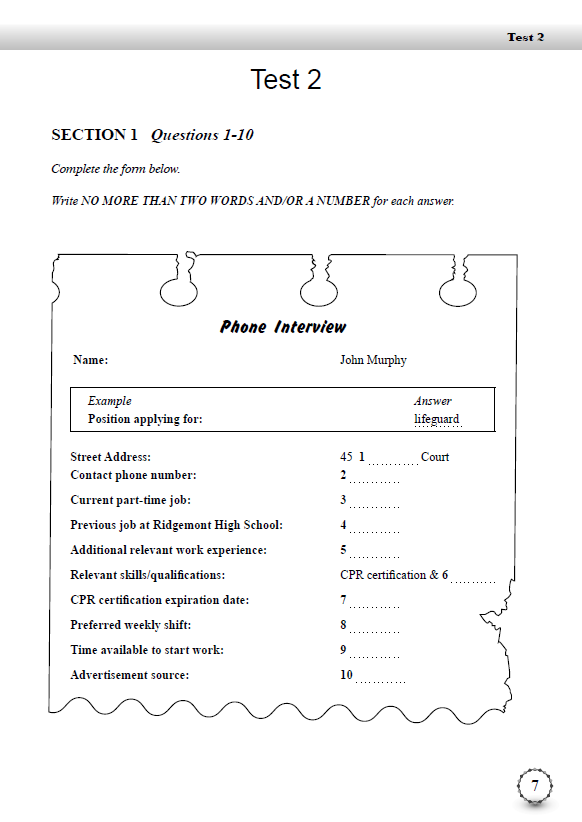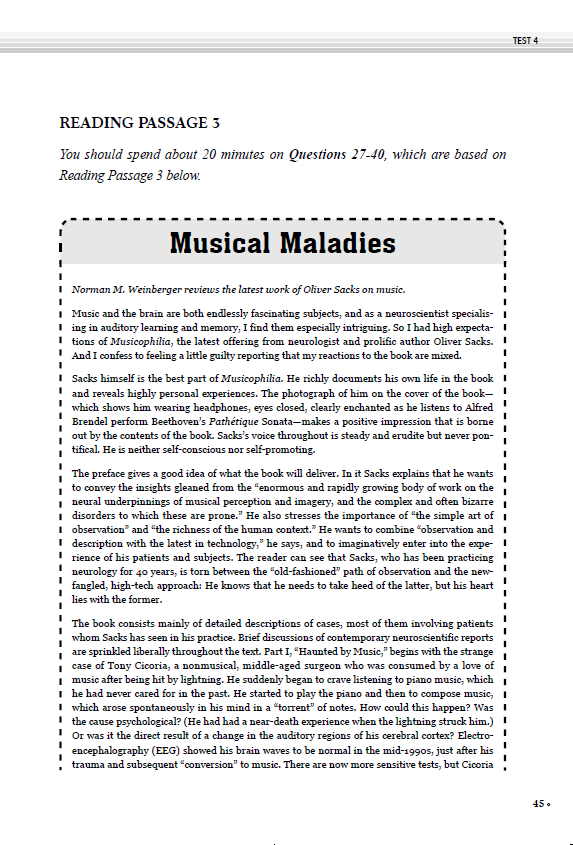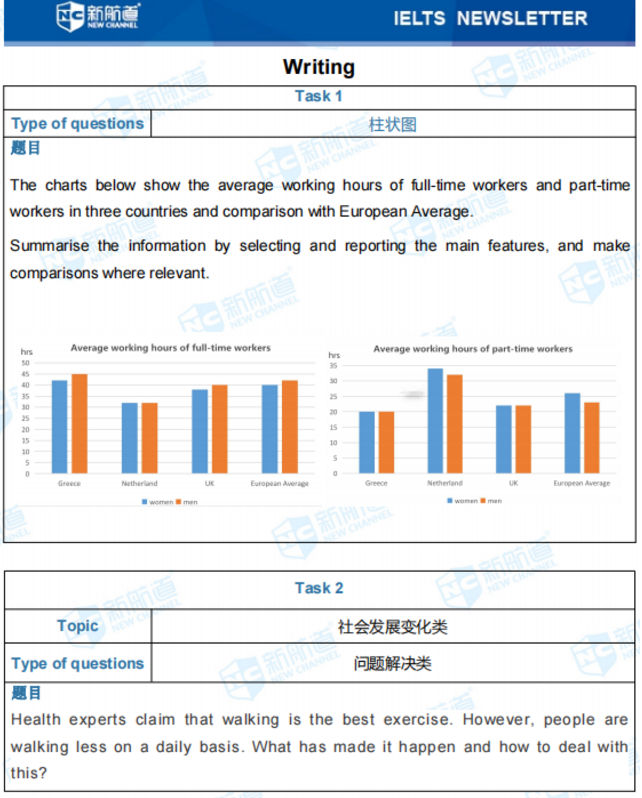摘要:今天上海新航道雅思培训班 小编为大家整理了2021年3月27日雅思考试真题答案回忆,每次考试后新航道雅思 小编会在1-2天内更新托福机经回忆
每场雅思考试之后,
分享本场A类雅思考试的参考回忆及解读。
2021/3/27 Saturday
各位烤鸭
3月27的雅思考试回忆
又有《9分达人》中的原题出现啦!
雅思听力机考Part 1对应
《9分达人雅思听力真题还原及解析2》
Test 2 Section 1
Applying for a Part-time Job

雅思阅读机考考试 Passage 3
对应
《9分达人雅思阅读真题还原及解析3》
Test 4 Passage 3
Musical Maladies

LISTENING
PART1(机考)
version
Topic
旧题
man makes a call to apply for lifeguard job
1-10为填空题
1. Address: Elsinore
2. cell phone No. 077896245
3. currently part time job: waiter
4. at a high school baseball coach
5. other relevant working experience: rescue diver
6. other certifications: diving
7. certificate expires in October
8. has a willing to work at Saturday
9.start at 6 o'clock
10. where he knows the job: on the radio
PART2(机考)
Version
Topic
旧题
女性人事经理向新员工介绍公司orientation活动的具体细节
11-15为选择题
11.B
12.C
13.B
14.A
15.C
16-20为匹配题
16.have photo taken
17.collect name badge
18.meet medical staff
19.give in paperwork
20.get equipment
PART3
version
Topic
新题
两名学生讨论presentation
21-24为匹配题
A need more examples
B can't not be done yet
C use existing overview
D fully prepared
E. too long
F. not relevant
21. Introduction— D(all done)
22.Course structure(not yetbusylalready made outline)
23.Technology ——E(cut them down)
24.Assessment materials ——Aplenty of/more to prove...
25-27为summary题
Interactive Activities
Participants are required to do a
27. listening task and they should work as a
28. group.Debate——they should communicate by writing short 27. notes.
28-30为summary题
28-30 Which Three things should be put in the conclusion of the presentation?
A. practices
B、 user-friendliness
C、emails
D. chatting room
E. typing skills
F. computer skills
G. global access
PART4
version
Topic
旧题
在沙漠中建一座新城
31-40为填空题
Current situation
31.Deserts need wind to cool down the street
32.Deserts can show consumption of electricity on a display for individuals.
33.The water temperature and time of having a shower can be regulated.
34.People can use electronic cars without a driver when they get around.
How engineers work
35.Build glass pavement on the roadsides, using mirrors to capture the sunlight.
36.There is a large umbrella shaped like a flower.
37.landscape: using ash adding into concrete with acid to the building's exterior
20 years later
38.There is a park in the heart of the city.
39.build a fountain for people to walk around.
40.In the future, houses will have lowest carbon emission
SPEAKING
Part 1
People & Animal
Meeting new people
Celebrities and stars
Events
Work & study
Recycling
Sports
Picnicking
Singing
Reading
Taking a rest
Activities
Listing things
Writing by hand
Try new activities
objects / Things
Color
Trees
Text message
Handwriting
Furniture
TV programs
Clothes
Presents and gifts
Places
Hometow
Accommodation
Farming
Museums
Home or apartment
The area you live in
Scenic views from a window
Plants and trees
Decoration
Country
Abstract
Major
Maths
In a hurry
Change
Future plan
Happiness
Bargain
Rest
Name
Concentration
stages in life
Color
New year
Weekend
Happiness
Part 2&3
People & Animal
Describe a person who wears unusual clothes穿着奇特的人
Describe a person who is polite礼貌的人
Describe a famous person you are interested in感兴趣的名人
Describe a time when you saw children behave badly in public熊能亥子
Describe an intelligent person聪明的人
Describe a time when it is important to tell your friend a truth告诉朋友真相
Describe a time when you got close to wild野生动物
Events
Describe an occasion when you lost your way in towns or cities迷路的经历
Describe a time when you felt bored无聊的经历
Describe a time when you made a promise to someone 对某人许诺
Describe a time you had to wait in line (queue up) for a long time排长队
Describe a time when someone was talking about something you were not interested inbut had to stay there 不感兴趣的话题
Describe a time when you give advice to others 给别人建议
Describe a time when you face a problem about computer电脑罢工
Describe a time when you need to use your imagination需要想象力
Describe a time when you ate something for the first time次吃某种东西
Describe a time when you were working with others in a group团队合作
Describe a time when you encouraged someone to do something that helshe didn't wantto do鼓励别人做不愿做的事情
Describe an event you experience in which you didn't like the music不喜欢音乐的经历
objects/Things
Describe a kind of weather you like喜欢的天气
Describe a toy that you had in your childhood童年喜欢的玩具
Describe a perfect job you want to have 想拥有的理想工作
Describe something you bought that pleased you买到开心的东西
Describe a short trip you often do but don't like to go 不喜欢的短途旅行
Describe something important that has been kept in your family for a long time对家庭重要的东西
Describe a film that made you laugh搞笑的电影
Places
Describe a part of a city or town you enjoy spending time in喜欢的城镇区域
Describe a home that you visited but did not want to live in去过但不想住的家
Describe a foreign country you want to know more about感兴趣的外国城市
Abstract
Describe an interesting conversation有趣的对话
Describe a skill that you think you can teach other people教别人的技能
Describe an ambition that you have had for a long time志向
Describe an interesting tradition in your country有趣的传统
Describe the area of science (e.g. physics, medicine, psychology) that you are interestedin感兴趣的科学
READING
Passage 1
Topic
The Baobabs of Madagascar
1-6为判断题
1.All baobabs species are found in this region. False
2. Grandildieri baobabs can be found in most areas of Madagascar. False
3.Adanson Michel and xXx Grandildieri were first European botanists whocame to study the trees. Not Given
4.Avene De XXX(地点)were formed because the growth of agriculture.True
5. Baobabs provide valuable products to local people.True
6. The reasons lead to the damage of Baobabs forests are clear. False
7-13为填空题
7. water near by area
8. cyclones
9. farming
10. logging activities
11. two kinds of animals are killed
12. maps
13.book
Passage 2(机考)
Topic
Should leaders be promoted from within the company, or hired from
outside?
14-18为匹配题
14.G
15.A
16.E
17.D
18.B
19-22为填空题
19.analysts
20.environment
21.salary
22. team
23-26为判断题
23. Not Given
24.Yes
25. No
26.Yes
Passage 3(机考)
Topic
Musical Maladies
9分达人3 test 4
Norman M. Weinberger reviews the latest work of Oliver Sacks on music.
Music and the brain are both endlessly fascinating subjects,and as aneuroscientist specialising in auditory learning and memory, l find them especiallyintriguing. So l had high expectations of Musicophilia,the latest offering fromneurologist and prolific author Oliver Sacks.And l confess to feeling a little guiltyreporting that my reactions to the book are mixed ( 27,31题) .
Sacks himself is the best part of Musicophilia. He richly documents his own life inthe book and reveals highly personal experiences.The photograph of him on thecover of the book which shows him wearing headphones,eyes closed,clearly enchanted as he listens to Alfred Brendel perform Beethoven's PathitiqueSonata--makes a positive impression that is borne out by the contents of the book(32题).Sacks's voice throughout is steady and erudite but never pontifical.He isneither self-conscious nor self-promoting.(28题)
The preface gives a good idea of what the book will deliver. In it Sacks explainsthat he wants to convey the insights gleaned from the enormous and rapidlygrowing body of work on the neural underpinnings of musical perception andimagery, and the complex and often bizarre disorders to which these are prone."He also stresses the importance of Mthe simple art of observation" and Mtherichness of the human context.He wants to combine observation and descriptionwith the latest in technology,"(29题)he says,and to imaginatively enter into theexpe-rience of his patients and subjects. The reader can see that Sacks, whohas been practicingneurology for 40 years,is torn between the old-fashionedpath of observation and the new-fangled,high-tech approach: He knows that heneeds to take heed of the latter, but his heart lies with the former.
The book consists mainly of detailed descriptions of cases, most of them involvingpatients whom Sacks has seen in his practice.Brief discussions of contemporaryneuroscientific reports are sprinkled liberally throughout the text.Part l,MHauntedby Music," begins with the strange case of Tony Cicoria,a nonmusical,middle-aged surgeon who was consumed by a love of music after being hit bylightning. He suddenly began to crave listening to piano music,which _ he hadnever cared for in the past. He started to play the piano and then to composemusic,1 which arose spontaneously in his mind in a u torrentw of notes. Howcould this happen? Was l the cause psychological? (He had had a near-deathexperience when the lightning struck him.) Or was it the direct result of a changein the auditory regions of his cerebral cortex? Electro-encephalography (EEG)showed his brain waves to be normal in the mid-1990s, just after his trauma andsubsequent Mconversionw to music. There are now more sensitive tests,but Cicoria has declined to undergo them; he does not want to delve into the causesof his musicality. What a shame!(30题)
Part ll,"A Range of Musicality," covers a wider variety of topics, but unfortunately,some of the chapters offer little or nothing that is new(33题).For example, chapter13, which is five pages long, merely notes that the blind often have better hearingthan the sighted. The most interesting chapters are those that present thestrangest cases. Chapter 8 is about "amusia,"an inability to hear sounds asmusic, and “dysharmonia,"a highly specific impairment of the ability to hearharmony,with the ability to understand melody left intact. Such specificdissociationsw are found throughout the cases Sacks recounts.
To Sacks's credit,part lll,"Memory,Movement and Music," brings us into theunderappreciated realm of music therapy. Chapter 16 explains how "melodicintonation therapy" is being used to help expressive aphasic patients (thoseunable to express their thoughts verbaDy following a stroke or other cerebralincident) once again become capable of fluent speech. In chapter 20,Sacksdemonstrates the near-miraculous power of music to animate Parkinson's patientsand other people with severe movement disorders, even those who are frozen intoodd postures. Scientists cannot yet explain how music achieves this effect.
Toreaders whoareunfamiliar with neuroscienceand musicbehavior,Musicophilia may be something of a revelation.But the book will notsatisfy those seeking the causes and implications of the phenomena Sacksdescribes.For one thing,Sacks appears to be more at ease dis* cussing patientsthan discussing experiments. And he tends to be rather uncritical in acceptingscientific findings and theories(34题).
It's true that the causes of music-brain oddities remain poorly understood.However,Sacks could have done more to draw out some of the implications of the careful observations that he and other neurologists have made and of thetreatments that have been successful.For example, he might have noted that themany specific dissociations among components of music comprehension,such asloss of the ability to perceive harmony but not melody,indicate that there is nomusic center in the brain ( 37题) .Because many people who read the book arelikely to believe in the brain localisation of all mental functions, this was a missededucational opportunity.
Another conclusion one could draw is that there seem to be no Mcuresff forneurological problems involving music. A drug can alleviate a symptom in onepatient and aggravate it in another, or can have both positive and negative effectsin the same patient. Treatments mentioned seem to be almost exclusivelyantiepileptic medications,which "damp down" the excitability of the brain ingeneral; their effectiveness varies widely ( 38题).
Finally,in many of the cases described here the patient with music-brainsymptoms is reported to have "normal”EEG results ( 39题) . Although Sacksrecognises the existence of new technologies, among them far more sensitiveways to analyze brain waves than the standard neurological EEG test, he does notcall for their use. In fact,although he exhibits the greatest compassion forpatients, he conveys no sense of urgency about the pursuit of new avenues in thediagnosis and treatment of music-brain disorders(36题).This absence echoes thebook's preface, in which Sacks expresses fear that wthe simple art of observationmay be lost" if we rely too much on new technologies. He does call for bothapproaches(40题), though,and we can only hope that the neurological communitywill respond.
27-30为单选题
27.The writer expected it to be better than it was.
28.He included autobiographic details in his book
29.He tries to come to terms with new technologies.30.He was unwilling to take more sophisticated tests.31-36为判断题
31. lt feels uncomfortable to give a well-respected writer a less than favourablereview.
32. Beethoven's Pathitique Sonata is a good treatment for musical disorders.33. Part ll provides a large number of new ideas about musicality.
34. Sacks should be more skeptical about other theories and findings.
35. Current drugs will be phased out with the development of study of music.
36. Sacks is impatient to use new methods to treat music-brain disorders.
37-40为匹配题
37. Loss of the ability to perceive harmony but not melody
答案: suggest musical centre is not located in the brain.
38. Different outcomes of treatments for patients
答案:means the effectiveness of drugs vary.
39.EEG scans of Sacks's patients
答案: show no music-brain disorders.
40.Sacks believes testing based on new technologies
答案: should not be used in isolation.
WRITING

免费领取最新剑桥雅思、TPO、SAT真题、百人留学备考群,名师答疑,助教监督,分享最新资讯,领取独家资料。
方法1:扫码添加新航道老师

微信号:shnc_2018
方法2:留下表单信息,老师会及时与您联系
| 课程名称 | 班级人数 | 课时 | 学费 | 报名 |
|---|---|---|---|---|
| 雅思预备课程6-10人 | 6-10人 | 80 | ¥13800 | 在线咨询 |
| 雅思入门段6-10人班 | 6-10人 | 80课时 | ¥18800 | 在线咨询 |
| 雅思强化段 6-10人班 | 6-10人 | 72课时 | ¥26800 | 在线咨询 |
| 雅思全程段 6-10人班 | 6-10人 | 192课时 | ¥45800 | 在线咨询 |
| 雅思精讲段6-10人班 | 6-10人 | 96课时 | ¥25800 | 在线咨询 |
| 课程名称 | 班级人数 | 课时 | 学费 | 报名 |
|---|---|---|---|---|
| 雅思强化段 20-30人班 | 20-30人 | 96课时 | ¥8800 | 在线咨询 |
| 雅思精讲段20-30人班 | 20-30人 | 96课时 | ¥7800 | 在线咨询 |
| 雅思全程段 20-30人班 | 20-30人 | 192课时 | ¥13800 | 在线咨询 |
| 课程名称 | 班级人数 | 课时 | 学费 | 报名 |
|---|---|---|---|---|
| 雅思预备课程6-10人 | 6-10人 | 126 | ¥15800 | 在线咨询 |
| 雅思强化段 6-10人班住宿班 | 6-10人 | 152 | ¥28800 | 在线咨询 |
| 雅思全程班 6-10人班住宿班 | 6-10人 | 304课时 | ¥50800 | 在线咨询 |
| 雅思精讲段 6-10人班住宿班 | 6-10人 | 152课时 | ¥29800 | 在线咨询 |
| 雅思入门段 6-10人班住宿班 | 6-10人 | 80课时 | ¥20800 | 在线咨询 |
| 课程名称 | 班级人数 | 课时 | 学费 | 报名 |
|---|---|---|---|---|
| 雅思强化段 20-30人班住宿班 | 20-30人 | 96课时 | ¥8800 | 在线咨询 |
| 雅思全程段 20-30人班住宿 | 20-30人 | 192课时 | ¥15800 | 在线咨询 |
| 雅思精讲段 20-30人班住宿班 | 20-30人 | 96课时 | ¥9800 | 在线咨询 |
| 课程名称 | 班级人数 | 课时 | 学费 | 报名 |
|---|---|---|---|---|
| 雅思一对一 | 1人 | 按需定制 | ¥980元 | 在线咨询 |
| 雅思托福预备班 | 6-10人 | 50 | ¥9800 | 在线咨询 |
| 雅思免费试听课 | 不限 | ¥0元 | 在线咨询 | |
| 雅思口语5月新题刷题实战营 | ¥999 | 在线咨询 |
热门搜索: 上海雅思培训 上海雅思培训机构哪家好 上海雅思封闭班 上海雅思1对1培训 上海雅思培训
免责声明
1、如转载本网原创文章,请表明出处;
2、本网转载媒体稿件旨在传播更多有益信息,并不代表同意该观点,本网不承担稿件侵权行为的连带责任;
3、如本网转载稿、资料分享涉及版权等问题,请作者见稿后速与新航道联系(电话:021-64380066),我们会第一时间删除。
地址:徐汇区文定路209号宝地文定商务中心1楼
乘车路线:地铁1/4号线上海体育馆、3/9号线宜山路站、11号线上海游泳馆站
总部地址:北京市海淀区中关村大街28-1号6层601 集团客服电话:400-097-9266 总部:北京新航道教育文化发展有限责任公司
Copyright © www.xhd.cn All Rights Reserved 京ICP备05069206


 微信公众号
微信公众号
 微信社群
微信社群